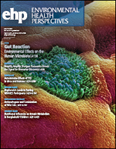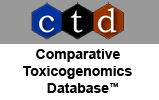Like many artists, Pam Jardieu and John Labadie suffer for their art. "I use a lot of really nasty adhesives," says Jardieu, a graduate student and instructor at the School of the Art Institute of Chicago who constructs kinetic sculptures from found objects. "On contact with certain materials, like toluene and lead, my fingers puff up. My whole hand puffs up and gets really red," she said. Labadie, a painter and art professor at the University of North Carolina at Pembroke, had an even more severe reaction after being exposed first to paint solvents and later to polyester fiber glassing resin while working his way through art school: "I had real problems with my hands. They started to break out right when the weather changed, when it got cold," he says. "I had X-ray treatments. I had salves I had to put on, and I had to wear latex surgical gloves at night. I had light therapy and I took prescriptions for the next year."
Although visual arts--such as painting, sculpting, printmaking, and metal work--are often thought of as benign pursuits, artists and craftspeople work with a wide range of potentially harmful materials. Each art discipline has its own battery of hazardous substances. Painters often use aromatic hydrocarbons such as toluene and styrene, esters such as butyl acetate, ketones such as isophorone, and glycols such as butyl cellosolve and methyl cellosolve acetate. Sculptors are exposed to metal fumes and dusts, sand and rock dusts, and, if they use organic materials, biological dusts such as molds, anthrax spores, and wood dusts. Other hazards are found in printmaking, ceramics, glassblowing, fiber arts, and photography. Artists may be at particularly high risk because they are most often self-employed, and so work in a relatively unregulated environment. They also often have lower incomes and are unable to afford safety equipment such as ventilation hoods and respirators.
"I think we were on the edge of what is acceptable, like a lot of people are in small industries," Labadie says. "[Schools] just hope that no one gets badly injured or too sick. Now I try to scare my students away from anything where I have any suspicions that that will go on. But I'm sure the same things are happening right now somewhere."
Every artist, it seems, knows at least one other artist who has had serious health problems related to the materials they use. For example, a ceramics teacher has silicosis and a collapsed lung; a painter has become hypersensitized to solvents and can no longer work with oil paints; or a potter and her young daughter have elevated levels of lead in their blood from applying and firing ceramic-tile glazes. Yet in spite of ubiquitous hazards in the arts, only a handful of industrial hygienists specialize in the health impacts of the artist's working environment. "The art community is so loosely organized that it's been difficult for agencies to identify it as a community that needs help," explains Gail Barazani, a former art teacher and environmental regulatory affairs specialist, and for 20 years the author of a column on health hazards in the arts.
Artists are a diverse group. According to the Bureau of Labor Statistics, in 1995 about 233,000 Americans were full- or part-time professional painters, sculptors, printmakers, or craftspeople. Another 136,000 were photographers. These numbers, however, don't account for the many artists who spend hours every week producing art but support themselves at "day jobs," and so identify themselves as waiters, secretaries, or taxi drivers. Also excluded from the statistics are hobbyists, college students, art teachers, senior citizens in therapeutic art programs, and children. And many of these professional, amateur, and fledgling artists are at risk.
Art History
Although the topic is currently not well-studied, the hazards of fine arts have been recognized since at least the early eighteenth century, when Bernardo Ramazzini, the "father of industrial medicine," discussed occupational risks to stone carvers and painters. In his 1713 tome
De Morbis Artificum Diatriba
(The Diseases of Workers), Ramazzini described hazardous materials that continue to pose risks to artists today. "For their liability to disease there is a more immediate cause," he wrote, "in materials of the colors they handle and smell constantly, such as red lead, cinnabar, white lead, varnish, nut-oil, and linseed oil, which they use for mixing colors; and the numerous pigments made of various mineral substances."

Care in handling?
Artists are notorious for making use of materials at hand, such as household containers which may be unsuitable for toxic chemicals, for storing and mixing media.
In fact, researchers have found evidence that at least some of the old masters were affected by the materials they used to create their masterpieces. According to physicians Lisbet Milling Pedersen and Henrik Permin at Hviolovre Hospital in Copenhagen, Denmark, the rheumatoid arthritis suffered by Paul Rubens (who had one of the first cases of the disease described in the literature), Auguste Renoir, and Raoul Dufy, and the scleroderma that plagued Paul Klee can be linked to the bright and clear colors that dominated their canvases.
These afflicted artists depended on colors based on toxic heavy metals more often than their contemporaries, who favored earth colors based on harmless iron and carbon compounds. Prolonged exposure to these substances--including mercury, cadmium, arsenic, lead, antimony, tin, cobalt, manganese, and chromium--can promote the development of inflammatory rheumatic diseases, as well as chronic lead and manganese poisoning.
Large-scale studies of the environmental hazards to contemporary artists have been relatively rare. The very diversity that makes the arts population hard to estimate also makes it hard to study. "If you want to study factory workers you can go to the company or you can go to the union. It's not such an easy thing for artists," explains National Cancer Institute scientist Aaron Blair. Two NCI studies conducted in the mid-1980s, however, did find higher risks for urinary bladder cancer, leukemia, and arteriosclerotic heart disease among painters. "We went to two different places and found this bladder cancer excess, which seems pretty convincing, I think," Blair says. These maladies were linked to the profession of painter, rather than to any particular material, raising questions among some as to their validity.
New Media
Although the old masters were exposed to an impressive array of potentially debilitating substances, trends in modern art have put contemporary artists in contact with a much wider assortment of materials. Today's artists will employ virtually anything in their creations, from commercially produced paints to discarded household appliances to esoteric materials not previously available such as plastics, molten ceramics, and acrylics.
"There is no hazardous chemical that isn't being used in an art department somewhere," says Monona Rossol, one of the few industrial hygienists specializing in arts safety. Rossol, founder and president of the nonprofit Arts, Crafts, and Theater Safety Corporation, first became interested in the subject of art safety while an art graduate student at the University of Wisconsin in Madison. To support herself, she worked as a research chemist (she holds a masters degree in chemistry) and commuted between the two departments daily. "I said, 'My God, there are the same acids, the same solvents, the same metals, pigments, dyes, all the kinds of stuff we work with in the chemistry department, they've got it over here in the art department'," she recalls. "It's the same chemicals, but the handling is entirely different and the [safety] knowledge isn't there."
Industrial hygienists specializing in the arts, such as Michael McCann, executive director of the Center for Safety in the Arts, report finding a staggering assortment of dangerous and often unlabeled materials in artists' workplaces. "In the last three [college-level] schools I inspected I found several quarts of cyanide electroplating solutions," McCann says. Combined with the acids printers often use, cyanide solutions produce hydrogen cyanide gas. "Now, you're talking about a slight accident and you can have a fatality within minutes." Ten years ago, on an inspection of a junior high school, McCann stumbled across a pound jar of uranium oxide. Prized for its brilliant oranges, uranium oxide was a popular colorant for ceramics and pottery glazes until it was banned about 10 years ago by the Atomic Energy Commission. Oxides of uranium and certain other colorant metals including arsenic, beryllium, cadmium, chromium, and nickel are known human carcinogens.
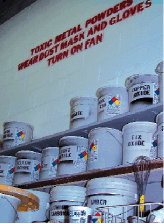
Glossing over the problem?
Many metal oxides used as pottery and ceramic glazes are known human carcinogens.
|
Typically, a potter preparing a glaze will scoop powdered glaze components--primarily silica and a flux, such as lead or barium, plus about 5% by weight of a metal oxide to provide color--out of their containers to mix with water, producing a slurry that is brushed onto the piece before firing it. Because the colorants are finely ground, they become airborne easily and pose an inhalation risk. Potters also run the risk of silicosis from inhaling the silica that forms the bulk of the glaze. But the greatest risk to many potters may be lead poisoning from handling lead and inhaling fumes while firing lead glazes. In England 100 years ago, more than 400 cases of lead poisoning were reported among potters. Although more careful housekeeping and the introduction of lead substitutes reduced the incidence of lead poisoning in commercial facilities, many fine artists continue to use lead glazes in less than pristine settings, risking exposure to themselves and their families. Children are also often exposed at school and summer camp, where pottery is an especially popular activity. And, according to McCann, although many school administrators realize that working with lead glazes is dangerous, they haven't been successful at making their classrooms lead-free.
"In every [elementary] school that had a pottery program where they were using glazes, I found lead glazes, even when they said they weren't buying them," McCann says of recent inspections. "Artists don't get rid of materials, so they had all these old materials that were still being used." Colleges didn't fare any better. "In almost all of the ones I've inspected in the last few years I've found lead glazes, most commonly a clear coating glaze, which they didn't realize was lead," he said.
At least lead is an established hazard whose use and effects health professionals recognize readily. New and unusual materials are steadily entering artists' studios, and are surprising and sometimes confounding health workers. "Artists are always experimenting with new materials to get different effects, so the exposures are continuously surprising," says Shirley Conibear, an occupational health physician who frequently treats artists.
Artists are just as likely to find materials in a junkyard, in a lumberyard, on the beach, or in a hardware store, as in a traditional art-supply store. This diversity of sources and materials--often unaccompanied by instructions or labels--can make predicting exposures difficult. As an example, Barazani tells of an University of Illinois art department teaching assistant--an asthmatic--whose sculptures were constructed of used refrigerators that he sliced apart with an electric saw. Working alone one night, he cut into a refrigerator's coolant container, which sprayed him with Freon, triggering a near-fatal asthma attack.
Although this may seem like a freak accident, artists frequently put themselves at risk, some say because they don't hold the same healthy respect for materials as other professionals. "They're not your normal breed of people in industry at all," says Ted Rickard, health and safety manager for the Ontario College of Art and Design in Toronto. "They're always experimenting, which means you have people mixing two chemicals together to see what happens or running something through a bandsaw and twisting it at the same time to make an interesting shape."
Risks of Experimentation
It's this devotion to experimentation combined with a general unfamiliarity with safety procedures as much as the materials themselves that endangers artists. Whereas a chemist might take a clearly labeled bottle of hydrochloric acid out of a ventilated cabinet to work under a ventilation hood near an eyewash station in a well-ventilated room, a printmaker is just as likely to pour the acid out of an unmarked jelly jar in a stuffy basement. "We know that chemicals are dangerous and the chemistry lab uses chemicals, but the perception is that art materials are not chemicals," McCann says.
Perhaps the widest assortment of dangerous chemicals in the arts are, in fact, found in the various types of printmaking: lithography (in which images are printed from drawings on stone or thin zinc or aluminum plates), intaglio (in which images are printed from acid-etched metal plates), photoetching (in which a photoresist is exposed to light), relief printing (in which areas of the plate, typically wood or linoleum, are cut away), and screen printing (in which a stencil is applied to a screen). Pigments include lead chromate, chromium, zinc chromate, strontium, and cadmium, all toxic metals. Printing equipment including plates, press beds, rollers, and slabs is cleaned with kerosene, chlorinated hydrocarbons such as trichloroethylene, and aromatic hydrocarbons such as toluene and xylene. Acids, including hydrofluoric, acetic, hydrochloric, tannic, phosphoric, and nitric acid, are used to etch plates.
"What [artists] do is simply a subset of what industrial workers do," says Rossol. "It doesn't matter if the trichloroethylene is being used as a solvent for paint to put on a canvas or whether it's being used as a degreaser for semiconductors." But, she says, factory workers are more likely to follow well-established safety procedures under the supervision of an industrial hygienist, while artists make due on folklore and hearsay. Rossol has, for example, found printmakers wearing respirators while etching plates with nitric acid. The thought is good, but no respirator cartridge is certified for protection against nitric acid. "If you don't have adequate ventilation, you just can't use nitric acid etching," she cautions.

Forced concessions.
Painters and other artists who come into contact with toxic media may be forced to wear protective gloves to avoid suffering skin damage.
Inadequate ventilation also can lead to overexposure to the solvents printers use, says Laurence Fuortes, a preventive medicine physician who often cares for members of the large Iowa arts community. Symptoms from these reactive compounds include burning eyes, nose, and throat; chest tightness; coughing; and asthma-like syndromes. In addition, "one of the major concerns with solvent accumulation is the euphoric and neurotoxic effects," Fuortes says. "One person who was working in a relatively confined space screen printing actually did have euphoric symptomology from overexposure to solvents, a narcotic-like effect. He was getting drunk."
Precautions and Changes
Good ventilation, however, is the exception to the rule in the artist's workplace, and few facilities have been designed properly for art production, Rossol says. Professional artists often work in studios they've constructed themselves on limited budgets. Children are exposed to art materials in ordinary classrooms, rustic summer-camp craft huts, and their parents' studios, often the worst setting because of the dangerous materials adults sometimes favor. Hobbyists may work on the dining room table--perhaps while cooking or eating--or in makeshift storefront craft shops. And even college art students working in buildings built with art in mind often suffer the consequences of poor designs and outdated practices

Child prodigies.
Children may still be exposed to hazardous art supplies in classrooms, homes, and summer camps.
"In my studio and the three next to me the ventilation is absolutely terrible. We're right next to the metal-grinding lab and it stinks and it's hot," says Jardieu of her space at the School of Art Institute of Chicago. "I'm not convinced that it's up to par." To foster a sense of community, the school removed the barriers between the students' studios. "People smoke in there, they grind metal, they do all kinds of stuff," Jardieu says. "So now instead of being exposed to just your own nastiness, you're exposed to 11 other people's."
Like many schools, however, the School of Art Institute of Chicago has recently reworked its ventilation system, including rerouting the ceramics studio's exhaust directly out of the building rather than through the photography studio. Taking an even larger step is the University of Wisconsin-Madison, which is spending more than $3 million to reventilate its art department. The department shares a large building whose ventilation system recirculates the air several times before exhausting it. Although recirculation is more energy-efficient than using heated or cooled air just once before exhausting it, a recirculating system also spreads fumes and particles throughout a structure. Single-circulation systems are standard in chemistry departments. "It was designed inappropriately to begin with because no one knew about the hazards," says Jack Wunder, a University of Wisconsin facilities engineer. "They thought chemistry's a hazard, not art. That's a sad commentary, but that's the way it was in the '60s."
Even recently built college art buildings, however, often are designed more like office buildings than chemistry labs, Rossol says. However, according to McCann, the National Association of Schools of Art and Design now includes safety standards among its criteria for certification or recertification. Still, recirculating air-handling systems seem to be the norm rather than the exception. Many work areas lack eyewash stations and emergency showers. Students' studios are arranged in large communal work groups so that contaminants are shared as well. In a large California school, a single large space was divided into 65 cubbyholes by flammable curtains. The students, many of whom worked with volatile solvents, had decorated their areas with paper and cloth. "And you could see the cigarette butts on the floor," Rossol says. "It was an incredible [accident] waiting to happen."
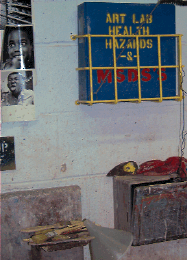
Lack of consideration.
Many art classrooms and studios make only cursory attempts to prevent hazards to health from art exposures.
|
Even the opposite approach--individual studios--can backfire. Realizing that many artists prefer to work and live in the same space, another art school--this one in Massachusetts--built a dormitory that included a combined studio, kitchenette, and sleeping area for each student. The unfortunate result for the students was 24-hour-a-day exposure to not only their own materials but those of other students, aggravated by the inadequate 300 cubic foot per minute bathroom fans installed as the sole means of ventilation.
At the least, the Massachusetts school duplicated the conditions under which many professional artists work. In spite of the risks, or more likely oblivious to them, about half of all artists work at home, and of those, about half work in living areas. That increases the chances of eating, touching, and breathing art materials, Conibear says. "There are all kinds of opportunities to contaminate themselves and [their] family that you don't have if you go somewhere to work." Home studios, she says, often place children in contact with materials--such as lead and other heavy metals--to which they are particularly vulnerable. "There have been a number of problems with people developing cottage industries out of their homes where they're doing these things in jerry-rigged situations, and they and their families have suffered the effects of overexposures," adds Fuortes.
Outside the Classroom
Unlike young adults, children are less likely to be exposed to art-materials hazards at school than at home, or worse, at summer camps where untrained teenagers working in primitive settings may supervise younger children working on such projects as making lead- or lithium-glazed drinking cups, McCann says. Most states publish lists of materials suitable for use in schools. The Labeling of Hazardous Art Materials Act of 1988 requires warning labels for materials that are not suitable for use by children and empowers the Consumer Product Safety Commission to obtain court injunctions against schools that purchase hazardous art materials for use in grades six and below. But although the act has improved arts-materials labeling, McCann says, many imported materials from countries with different regulations or from small-scale manufacturers may be labeled incorrectly. "They don't have the knowledge or the money to put into having a certified toxicologist evaluate the label. That gets expensive," he explains. "In a cottage industry, they may not be aware of the true hazard within their products," adds University of Wisconsin environmental hygienist William Deppen.
It is also possible that materials now thought to be safe for children will later be found hazardous. Rossol warns in particular of popular low-temperature modeling clays. Manufacturers of these brilliantly colored polymer clays have substituted as a plasticizer untested complex glycol ethers for the primary phthalate ethers (diethylhexyl phthalate or DEHP), which are now known to be animal carcinogens. The ethers are absorbed through the skin and, to a lesser extent, can be inhaled when the clay is fired. Such clays may also pose a problem, says McCann, because they may be used at home and fired in a family's oven that is also used for cooking. "If I could draw you the two sets of molecules, the DEHP and the ones they replaced them with, you would see how closely similar they are," Rossol says. "And yet since they have never been actually tested for long-term hazards, they can continue to label the product nontoxic."
In fact, Rossol says, very few dyes and pigments have been studied, especially organic chemicals. Rather than label those products--particularly those closely related to known toxic or carcinogenic chemicals--as nontoxic, she suggests a label that reads: "This pigment has never been tested for long-term hazards."
In spite of the protections afforded to children and improvements in product labeling, most artists work in an unscrutinized, loosely regulated world. Of the 4,000 or so workplace investigations that the National Institute for Occupational Safety and Health's Hazards Evaluation and Technical Assistance Branch has conducted in the last 10 years, only two of those requested have been in the arts. The branch does, however, answer thousands of phone inquires each year, some of which come from artists, according to Assistant Branch Chief Rick Hartle. And although any nongovernmental business that employs more than one person is regulated by the Occupational Safety and Health Administration, that standard misses the bulk of artists, most of whom are self-employed, students, or amateurs.
Such people tend to fall through the cracks in the regulatory system. "They tend to regulate their own workplace and not have someone enforcing the rules and they don't have a good way to get into the protective equipment market so that purchasing ventilating systems or even respirators is sometimes problematic for them," says Conibear. "The whole MSDS [Material Safety Data Sheet], right-to-know system breaks down when you get to a self-employed worker."

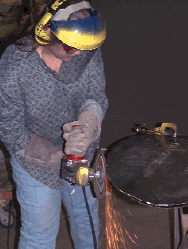
A Safer Way.
Metalworking and woodworking can expose artists to hazardous dusts and noise. Protective gear such as face shields and earprotectors are advocated but not always used.
Art-hazards experts have no shortage of suggestions for ways that the lives of artists could be made safer through regulation and education. Manufacturers could be compelled to test products more extensively and label them more accurately. Art-safety courses could become a required part of the curriculum of any program--whether elementary school, college, university, or craft shop--that provides instructions in the arts. Artists could switch to safer, if more time-consuming, materials and techniques. Printmakers, for example, could clean their plates with strong detergent rather than solvents. And just teaching painters to stop licking their brushes to a point could greatly reduce their ingestion of dangerous pigments. Arts colleges could limit access to studios to a reasonable workday, rather than encouraging overexposure with heavy workloads and strict deadlines, a practice Rossol likens to "hazing." All schools could be subjected to inspections by certified industrial hygienists trained to recognize the techniques, tendencies, and tools of artists. Schools could require their instructors to apply for permission to introduce any untested, unapproved, or newly invented material or technique to the classroom.
But if there is a single point that art and health professionals agree upon, it's that members of the arts community, including working artists, art instructors, and art administrators, need to make a great leap in their understanding of arts safety. Whether artists are willing to learn, however, is another question.
Perhaps, Rossol and Rickard suggest, artists have learned to shun safe practices as a badge of membership in the arts subculture. Rickard recites a litany of foolhardy practices he's seen in his institution alone: a visiting instructor who nailed a block of expanded polystyrene to the wall of the classroom and set fire to it so his students could see what kind of pattern the smoke made on the white wall; a faculty member found sitting in a large pool of mineral spirits, lost in thought; students using solvents, plastic resins, and epoxies in unventilated studios, although ventilation hoods are available.
"Artists are a very strange breed of people," Rickard says. "They tend to be quite antiestablishment, antiauthority. If the rules say do this, they'll do the opposite quite deliberately." Or perhaps artists feel that "it's a risk you're willing to take because you're excited by the materials and their potential," Barazani says. Or maybe "these artists are not casual with the materials they're working with because they feel they know them so well that they don't have to worry about them," Conibear says, "but rather they're mostly just ignorant and just haven't thought of it in that context."
The most compelling explanation may be a combination of a dangerous attitude and ignorance of dire consequences. "The self-employed artist may be socialized to be above such mundane concerns. They're thinking on a higher plane. They're creators," says Fuortes. "But once someone has health problems, they're extremely attentive."
Scott Fields
Last Update: March 20, 1997


